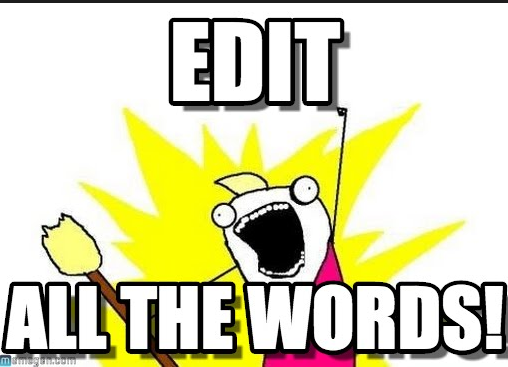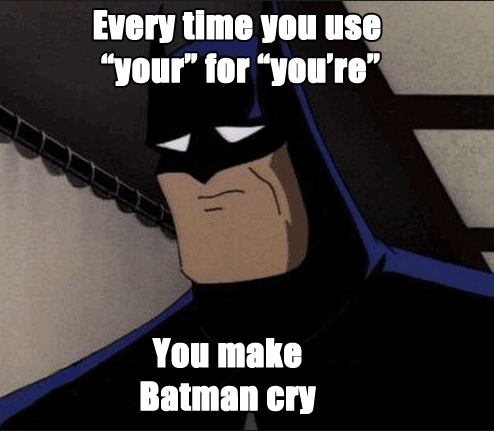Kiss Your “As” Goodbye: A Simple Grammar Trick for Better Fiction
Today, AWESOME W.A.N.A. International Instructor and author-editor-teacher-extraordinaire Marcy Kennedy is here to guest post about a dreaded topic—GASP—grammar. Yes, I admit it. I’m a Grammar Nazi. I remember correcting my eldest nephew when he was learning to talk. Steaks are good, people are well. Chickens are done, people are finished. We raise crops, and rear children.
This was being a good auntie.
Then he went off to first grade…
His teacher asked him if he was done, and he matter-of-factly replied, “Chickens are done, people are finished.”
So yes, I’ve had to learn to not be a jerk about grammar (and gently correct the kiddos even though I was cheering inside). But take heart, if a Grammar Nazi makes an error, we get 543 e-mails correcting us.
Even Grammar Nazis oops. We need refreshers and ALL need a fresh set of eyes on our work because a lot of subtle grammar bugaboos can still slip through even the most highly trained filters.
Proper grammar, spelling and punctuation are critical for all books. Maintaining the reader’s fictive dream is paramount. Few things can slam the brakes on flow like poor grammar. Think of it this way. We could be wearing the latest, greatest design by Versace, but if we have the back tucked in our underpants or our fly open? Tough for others to see and appreciate our “fashion.”
This said, the best person I know to teach grammar is Marcy, so take it away!
****
A good grade in a high school or college English class doesn’t necessarily translate into the ability to write great fiction, so it’s easy for us to mistakenly think understanding grammar isn’t important for fiction writing at all. Isn’t that what a copy editor is for? Won’t they fix all your mistakes?
A copy editor will fix our actual errors, but some of the rules we were taught in English class will actually hurt our fiction writing, not help it. And some easy grammatical tricks that our copy editor won’t do for us can improve our fiction.
In my work as an editor, one of the most common mistakes I see made by fiction writers is the reversal of the necessary order of cause coming before effect, action coming before reaction.
When we reverse the two so that the effect comes first or comes at the same time as the cause, our readers will feel thrown off-balance and disconnected from our writing, even if they can’t always explain why. In real life, cause always comes before effect. The effect can’t come before what caused it. They expect the same in fiction (unless we’re writing a science fiction story with a temporal paradox, of course).
Let me show you what this cause-and-effect problem looks like in our fiction, and then I’ll give you a super-simple editing trick that will help you catch it and kiss it goodbye.
Example #1:
As the shot rang out, Ellen covered her ears.
The word “as” is used as a connection between things that are supposed to be happening at the same time.
But in the example above, the shot and Ellen covering her ears aren’t happening at the same time. They can’t happen at the same time. Not unless she’s psychic. She couldn’t have done what the sentence says because, until she heard the shot, Ellen had no reason to cover her ears.
Here’s what the sentence might look like if we fixed it.
The shot rang out, and Ellen covered her ears.
Example #2:
He blushed as he realized his fly was undone.
Blushing is the result or effect of realizing his fly is undone. He realizes his fly is undone, and as a result, his face heats. This sentence feels odd because the cause and effect are flipped.
So what we’d actually want to write is something like…
He realized his fly was undone, and heat rushed up his face.
(Realized is a dangerous word in our fiction as well, and was only used here to help with this example. In a real book, we’d want to show him realizing his fly was undone rather than telling the reader he realized. If you’d like to learn more, check out Mastering Showing and Telling in Your Fiction: A Busy Writer’s Guide.)
Example #3:
We took cover when we heard him entering the building.
“When” works similarly to “as.” It suggests that the two things happened simultaneously.
The problem is that they didn’t take cover at the same time as they heard him entering. Until they heard him entering, they had no reason to take cover. First they heard him entering, and then, as a consequence of hearing it, they took cover.
Here’s one way we could fix this.
The heavy metal door rattled on its hinges, and the sound of footsteps ricocheted around the hangar. We dove behind a stack of crates.
A related problem is when we create a sentence where we’re not suggesting things are happening at the same time, but we’ve still reversed the natural order of cause and effect in the way we’ve structured the sentence.
Example #4:
My mouth went dry and a heavy weight settled in my chest as he led me down the hall to meet my birth mother for the first time.
Technically, this can happen at the same time. This is one of those situations that can justify breaking the linear rule because walking down the hall takes time. There’s time for something to happen as she’s walking.
Here’s the problem. Our sentence structure still needs to reflect the natural order. Even if we want to express that something is happening at the same time, when we write it, we need to give the reader the cause before we give them the effect.
In the above example, we find out our narrator’s mouth is dry and she feels a heavy weight on her chest, but the reader will feel ungrounded because they have no idea what’s causing it. Any time the reader loses connection to the POV character and immersion in the story, it’s a bad thing.
We’ll find this in our writing when our words express that one thing happened temporally before the other, but in the sentence we’ve reversed the order in which we tell the reader about them. So we’re meaning “A happened before B,” but in our sentence what we’ve written is “B happened because of A.”
We need to write down the cause (A) before the effect (B).
Before I give you the editing tip, let’s quickly go back to the example above and see one possible way we could rewrite it, keeping this in mind.
He led me down the hall to meet my birth mother. My mouth went dry and a heavy weight settled in my chest.
Most of these mistakes happen when we’re trying to vary our sentence structure. Variety in sentence structure is good, but not at the expense of making sure each sentence is also structurally sound.
Quick Editing Tip

Image courtesy of Hyperbole and a Half (http://hyperboleandahalf.blogspot.com)
The easiest way to spot this problem is to look for the words as, while, and when. This is where the Find and Replace feature in your word processing program will become your best friend.
In the Find box write as, and in the Replace box write AS. Make sure to select the option of “Find Whole Words Only.” If you wanted to get fancy, you could even use the option to bold the AS, but capitalizing it is enough to make it stand out on the page. Do the same for while and when.
Now you can skim through your book and quickly check each instance to see if it should stay or if you’ve reversed your cause and effect.
Want More Help With Grammar for Fiction Writers?
Check out my book Grammar for Fiction Writers: A Busy Writer’s Guide. The world of grammar is huge, but fiction writers don’t need to know all the nuances to write well. In fact, some of the rules you were taught in English class will actually hurt your fiction writing, not help it. Grammar for Fiction Writers won’t teach you things you don’t need to know. It’s all about the grammar that’s relevant to you as you write your novels and short stories.
Here’s what you’ll find inside:
• Punctuation Basics including the special uses of dashes and ellipses in fiction, common comma problems, how to format your dialogue, and untangling possessives and contractions.
• Knowing What Your Words Mean and What They Don’t including commonly confused words, imaginary words and phrases, how to catch and strengthen weak words, and using connotation and denotation to add powerful subtext to your writing.
• Grammar Rules Every Writer Needs to Know and Follow such as maintaining an active voice and making the best use of all the tenses for fast-paced writing that feels immediate and draws the reader in.
• Special Challenges for Fiction Writers like reversing cause and effect, characters who are unintentionally doing the impossible, and orphaned dialogue and pronouns.
• Grammar “Rules” You Can Safely Ignore When Writing Fiction
****
THANK YOU, Marcy!
We love hearing from you! Are you a Grammar Nazi? Do family members weep with jubilation when you mess up and they finally can correct YOU? Do you struggle with grammar? I confess, the whole “lay vs. lie” thing twists my brain in a know and I STILL have to google it (or usually simply rephrase).
I love hearing from you! Comments and questions for guest count DOUBLE, so I hope y’all will show Marcy some love.
To prove it and show my love, for the month of SEPTEMBER, everyone who leaves a comment I will put your name in a hat. If you comment and link back to my blog on your blog, you get your name in the hat twice. What do you win? The unvarnished truth from yours truly. I will pick a winner once a month and it will be a critique of the first 20 pages of your novel, or your query letter, or your synopsis (5 pages or less).

Marcy Kennedy, W.A.N.A. Instructor Extraordinaire
ANNOUNCEMENTS:
Back to School!
Going Pro Series NOW Available ON-DEMAND
Going Pro Craft , Going Pro SocialMedia/Branding and Going Pro Business or ALL THREE! W.A.N.A.’s bundle deal, Going Pro All the Way! . Use WANA15 for $15 off individual classes. Recording and detailed noted come with purchase.
For those who need help building a platform and keeping it SIMPLE, pick up a copy of my latest social media/branding book Rise of the Machines—Human Authors in a Digital World on AMAZON, iBooks, or Nook.








